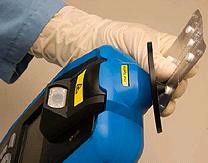US may roll out handheld scanners to border points
Phil Taylor, 07-May-2010
 The US Food and Drug Administration is considering rolling out handheld spectrometer units for use as screening devices to guard against counterfeit drugs entering the country's borders.
The US Food and Drug Administration is considering rolling out handheld spectrometer units for use as screening devices to guard against counterfeit drugs entering the country's borders.
Fred Fricke, director of the FDA's Forensic Chemistry Center, said at the European Compliance Academy's recent Strategies against Counterfeit Medicines conference in Wuerzburg, Germany, that handheld devices are likely to play a key role in preventing fake medicines entering the US market.
Fricke told SecuringPharma.com that scientists at the FCC laboratory in Cincinnati, Ohio, are currently putting handheld Raman and FT-IR spectrometers through their paces and may recommend deploying several of the units at several key facilities around the country for use by US Customs and Border Protection (CBP) personnel.
The FCC's ongoing assessment of the units – the TruScan Raman spectroscopy device and TruDefender FT-IR unit developed by Ahura Scientific (now part of Thermo Fisher) – has so far included a method validation study in which samples of commonly-counterfeited products were examined to see how effective the TruScan scanner was in achieving a correct reading.
The study looked at 240 counterfeit tablets of three erectile dysfunction products - Pfizer's Viagra (sildenafil), Eli Lilly's Cialis (tadalafil) and Levitra (vardenafil) sold by GlaxoSmithKline, Bayer and Schering-Plough - and also Pfizer's cholesterol-lowerer Lipitor (atorvastatin).
Lab-based FT-IR and image analysis had previously determined all the samples to be counterfeit. The handheld Raman scanner correctly identified 94 per cent of the counterfeits, providing false-negative results for just 6 per cent of them (14 tablets).
"These are really great screening tools," Fricke told the conference, noting that if a suspect product appears to be counterfeit FDA's Forensic Chemistry Center will still carry out lab-based analyses to check the result.
Despite the false-negative rate, he believes locating the units at ports of entry into the USA should still pick up a lot of counterfeits, and will be a major improvement over the current situation which relies largely on visual inspection.
"I think a combination of Raman and FT-IR scanning would pick up a lot of the false-negative rates," said Fricke, who said his team is now starting to assess the capabilities of the TruDefender handheld FT-IR unit.
There are also plans to set up a system whereby agents in the field can send the spectra generated by the handheld units via wireless connection to the FCC lab so they can be double-checked by specialist staff.
"That would be particularly useful where the results are not clear and could give the possibility of a false-negative verdict," said Fricke.
The FDA says it has a library of Raman spectra for 57 finished dosage forms, including multiple dosages, as well as 70 standards for active pharmaceutical ingredients (APIs) and excipients.
Related articles:
NAFDAC praises TruScan role in Nigerian counterfeit fight
Thermo completes $145m Ahura Scientific purchase
Nigeria convicts fake drug importer, closes rogue pharmacies
Ahura scanners bound for Nigerian drugs regulator
Ahura sales top $100m threshold

©
SecuringIndustry.com




 The US Food and Drug Administration is considering rolling out handheld spectrometer units for use as screening devices to guard against counterfeit drugs entering the country's borders.
The US Food and Drug Administration is considering rolling out handheld spectrometer units for use as screening devices to guard against counterfeit drugs entering the country's borders.